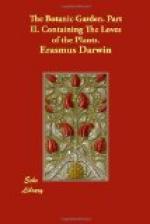The
silvery sea-weed matted round her bed,
And
distant surges murmuring o’er her head.—
High
in the flood her azure dome ascends,
270 The crystal arch on crystal columns bends;
Roof’d
with translucent shell the turrets blaze,
And
far in ocean dart their colour’d rays;
O’er
the white floor successive shadows move,
As
rise and break the ruffled waves above.—
275 Around the nymph her mermaid-trains repair,
And
weave with orient pearl her radiant hair;
With
rapid fins she cleaves the watery way,
Shoots
like a diver meteor up to day;
Sounds
a loud conch, convokes a scaly band,
280 Her sea-born lovers, and ascends the strand.
E’en
round the pole the flames of Love aspire,
And
icy bosoms feel the secret fire!—
Cradled
in snow and fann’d by arctic air
Shines,
gentle BAROMETZ! thy golden hair;
285 Rooted in earth each cloven hoof descends,
And
round and round her flexile neck she bends;
Crops
the grey coral moss, and hoary thyme,
Or
laps with rosy tongue the melting rime;
Eyes
with mute tenderness her distant dam,
290 Or seems to bleat, a Vegetable Lamb.
[Barometz. l. 284. Polypodium Barometz. Tartarian Lamb. Clandestine Marriage. This species of Fern is a native of China, with a decumbent root, thick, and every where covered with the most soft and dense wool, intensely yellow. Lin. Spec. Plant.
This curious stem is sometimes pushed out of the ground in its horizontal situation by some of the inferior branches of the root, so as to give it some resemblance to a Lamb standing on four legs; and has been said to destroy all other plants in its vicinity. Sir Hans Sloane describes it under the name of Tartarian Lamb, and has given a print of it. Philos. Trans. abridged, v. II. p. 646. but thinks some art had been used to give it an animal appearance. Dr. Hunter, in his edition of the Terra of Evelyn, has given a more curious print of it, much resembling a sheep. The down is used in India externally for stopping hemorrhages, and is called golden moss.




